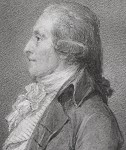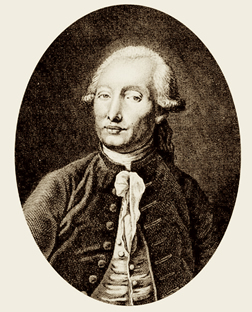|
Date of Birth |
27 February 1748. |
Place of Birth 
|
Tensta, Uppland, Sweden. |
|
Date of Death |
9 August 1820.
|
Place of Death 
|
Stockholm, Sweden.
|
Monuments Medals Etc. 
|
- Memorial stamp, the Swedish Post office 1973, portrait of Anders Sparrman, illustrated with a tropical island and ships in the background.
- Memorial stamp, the French Post office 1986. The stamp depicts James Cook’s map over Tahiti added with portraits of Anders Sparrman and Daniel Solander.
|
|
Variations of Name's Spelling |
First name sometimes
spelled Andreas.
|
|
Preserved signature |
In correspondence.
|
|
Portrait |

Portrait of Anders Sparrman, miniature by Niclas Lafrensen d.y.
[Source; Nationalmuseum, Stockholm, Sweden].

Engraving by Hubert, after drawing by M. Mollard, (this
depiction was used on the memorial stamp from 1973). |
|
Childhood, Adolescence & Education |
- Father, dean and vicar, Master of Philosophy Eric Sparrman.
- Mother, Brita Högbom.
- Student, Uppsala University 1757, already at the age of nine. The young Sparrman is believed to have alternated between home education and university studies, and was first in full time studies at the university when he was 14 years old.
- He started medicine studies 1762.
- Medical exam 1770.
|
|
Professional Life |
- Sparrman took a break in his studies to work as a ship’s doctor’s assistant 1765-1767 on a voyage to China.
- Doctor of Medicine 1775, in his absence, for the reason of his long voyage from January 1772 until July 1776.
- After the return from the voyage 1776; Sparrman arranged and classified his large botanical, zoological and ethnographical collections from Africa and visited areas during the circumnavigation.
- Keeper for the natural history cabinet at The Royal Swedish Academy of Sciences during the period 1777- 1798. He also managed to publish his African travel journal during this period.
- Fellow of The Royal Swedish Academy of Sciences 1777, he as well became a fellow of several other Swedish and foreign academies after the voyage.
- Professor in Stockholm, 1781.
- Professor in natural history and pharmacy in Stockholm, 1790-1803.
- Assessor at Collegium medicum in Stockholm 1803.
- Doctor to the poor in Klara parish in Stockholm 1814.
- Added to above mentioned work after his voyage 1776; Sparrman published the rest of his travel journal 1802 and 1818, he also published a Swedish ornithology with colour plates during the period 1805-1816 and learned the new engraving technique. He also felt obliged to maintain a reasonable standard of living for his elderly mother and unmarried sisters.
|
Journeys & Voyages 
|
- Ship’s doctor’s assistant Swedish East India Company, on the ship Stockholms Slott to India and China 1765-1767. (The journey was financed with his employment onboard).
- He travelled 10 January 1772 from Gothenburg and arrived 12 April in Cape with the Swedish East India Company ship Stockholm Slott, on its way to China. (Sparrman got a free voyage with the help of The Royal Swedish Academy of Sciences’ contacts with the directors at the Swedish East India Company, for the reason that his journey was seen as “scientifically useful”. Sparrman’s first period in the Cape area was on the other hand financed with a combination of scholarships and his employment as tutor).
- He studied natural- and social history in the southern reaches of Africa, when in the vicinity of Cape Town. Sparrman’s stay in the Cape was interrupted sooner than he had expected, when he got a new travel offer which he could not refuse. He was asked to join James Cook on his second circumnavigation of the earth (1772-1775). Two ships were used for the expedition, Resolution and Adventure. His work involved helping with research and mapping the Southern Ocean, New Zealand, Oceania and the South American coast. They visited; New Zealand, French Polynesia, Tonga, Fiji, Vanuatu, New Caledonia, Easter Islands, Marquesas Islands and Argentina. (Sparrman was employed as a paid botanical assistant to the naturalists, Johann Reinhold Forster and his son Georg Forster on the ship Resolution).
- James Cook’s ships sailed from Cape 22 November 1772 and was back in Cape 22 March 1775. Sparrman and his fellow travellers had to cope with many difficulties during the long voyage; primarily the cold, only six months of nearly two and half years was spent on land and many of the plants had already been “discovered” by Joseph Banks and Daniel Solander during the previous circumnavigation.
- Sparrman continued after the return to Cape in March 1775 with his botanical and zoological observations in the southernmost Africa. He also travelled inland on an almost one year long journey, longer than any European before him. Besides his natural history studies, he took great interest in the inhabitants traditions and collected ethnographica and he prepared a map of the colony.
- Sparrman returned to Sweden in May 1776, and sailed with the same East India ship Stockholms Slott , as he had travelled with four years earlier. He returned to Gothenburg 29 June 1776.
- Sparrman travelled to England during a couple of months 1776-1777, to arrange the collections from the circumnavigation together with Johann Reinhold Forster and his son Georg Forster.
- Sparrman travelled to West Africa and primarily Senegal 1787-1788, for the reason to find a suitable place for a Swedish colonisation, but he and his company had no success with their plans.
|
Travel Diaries & Other Publications in Connection with the Journeys & Voyages 
|
- His travel diaries were published in four languages between 1783 and 1818. Resa till Goda Hopps-Udden, södra Polkretsen och omkring Jordklotet, samt till Hottentott- och Caffer-Landen Åren 1772-1776. Vol. 1. 1783, Vol II.1 1802, Vol. II. 2 1818.
- Tal om den tilväxt och nytta, som Vetenskaperne i allmänhet, särdeles Natural-Historien, redan vunnit och ytter- ligare kunna vinna, genom undersökningar i Söder-hafvet. Praesiddii-Tal i Kongl. Vetenskaps Academien 1778. (Printed speech held at The Royal Swedish Academy of Sciences related to Sparrman’s long journey).
|
|
Civil Status & Family |
Unmarried, but lived with a lady
and had a daughter by her.
|
Preserved Collections & Manuscripts 
|
- Large ethnographical collections from Sparrman’s four year long journey are kept in Stockholm at the Museum of Ethnography.
- “Drawing of a Sepia..., Drawing of fishes..., Two pencil drawings of a crab..., A description of a plant..., manuscripts by Sparrman and letters from Sparrman to Carl Linnaeus, The Linnean Society of London.
- Water colours depicting plants collected by Sparrman together with father and son Forster during the circumnavigation. Water colours by Georg Forster. National History Museum, Botany Library, London.
- Herbarium plants collected by Sparrman can be studied in several collections, foremost; Retzius herbarium in Lund, The Swedish Natural History Museum and Bergius Herbarium both in Stockholm, Uppsala University Herbarium, The Cathedral school in Linköping, Komarov Institute in St Petersburg and The Linnean Society of London.
- Zoological specimens collected by Sparrman, The Swedish Museum of Natural History, including the now extinct quagga.
- Sparrman’s private papers, correspondence, field notes, journals etc. all is believed to have disappeared around the time of his death 1820.
- Letters, The Linnean Society of London, Linnean Correspondence (11 letters from Sparrman to Linnaeus, 1771-1775).
|
|
Extra Notes |
- Sparrman was hard-working, but much of his scientific observations came in the shadow of the contemporary apostle Carl Peter Thunberg, who also visited Cape, published his scientific results and ideas more frequently than Sparrman and besides became the successor to the Chair of Botany after Carl Linné the younger.
- The African plant Sparrmania africana, a tree of the linden family, Tiliaceae, was named by Carl Linné the younger after Anders Sparrman. It is well known in cultivation, also as an indoor pot plant.
|
|
Added Knowledge |
Discover... |





 The Thora Ohlsson Foundation, Lund, Sweden
The Thora Ohlsson Foundation, Lund, Sweden
 The Thora Ohlsson Foundation, Lund, Sweden
The Thora Ohlsson Foundation, Lund, Sweden











